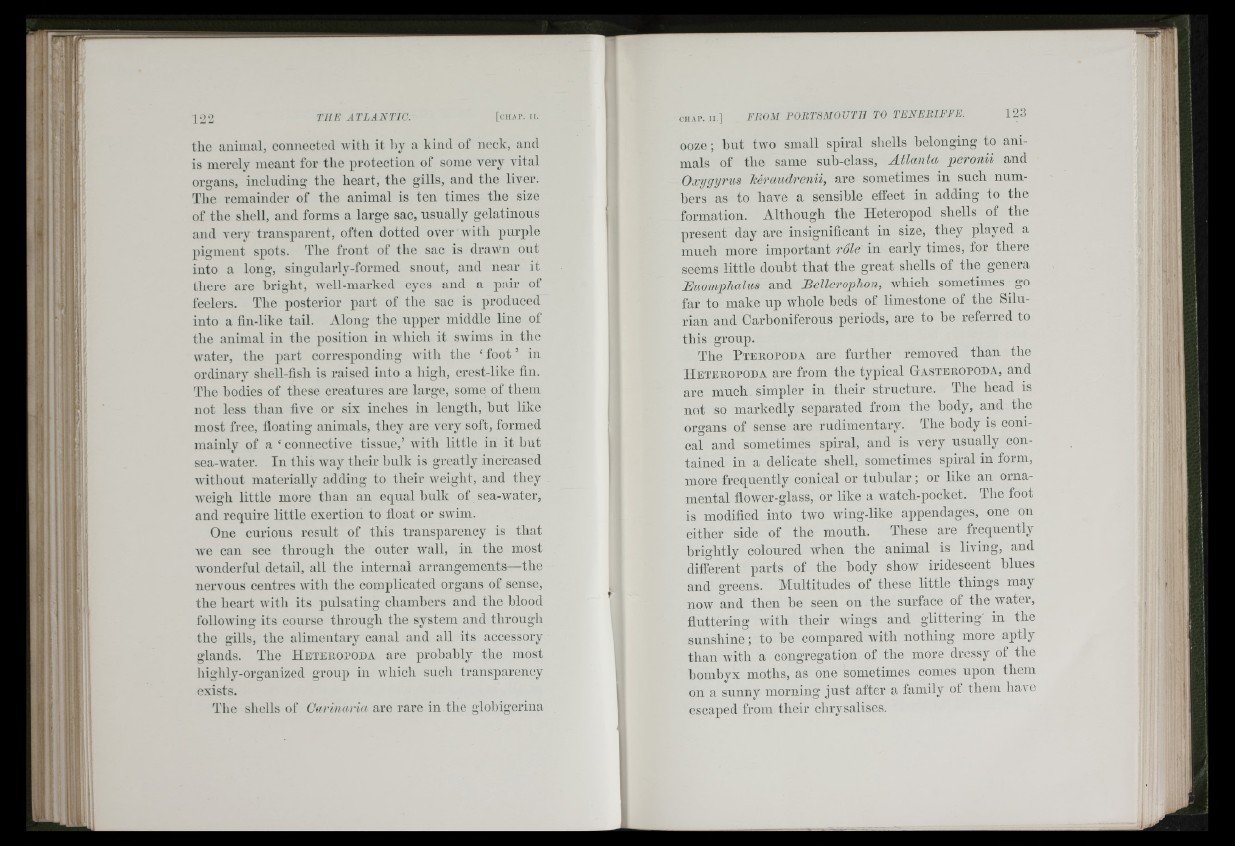
12-2
the aiiiiual, connected Avitli it hy a kind of neck, and
is merely meant for tlie protection of some very vital
organs, including the heart, the gills, and the liver.
The remainder of the animal is ten times the size
of the shell, and forms a large sac, usually gelatinous
and very transjiarent, often dotted over Avitli purple
pigment spots. The front of the sac is drawn out
iuto a long, singularly-formed snout, and near it
there are bright, Avcll-marked eyes and a pair of
feelers. Tbe posterior part of the sac is produced
into a fin-like tail. Along tbe upper middle line of
tbe animal in tbe position in which it swims in tbe
water, the part corresponding with the ‘ foot ’ in
ordinary sliell-fisli is raised into a high, crest-like fin.
The bodies of these creatures are large, some of them
not less than five or six inches in length, but like
most free, floating animals, they are very soft, formed
mainly of a ‘ connective tissue,’ with little in it but
sea-Avater. In tins AA'ay tlieir bulk is greatly increased
Avitliout materially adding to their Aveiglit, and they
AA'eigli little more than an equal bulk of sea-Avater,
and require little exertion to float or SAvim.
One curious result of this transparency is tbat
Ave can see tlirougli tbe outer Avall, in the most
AVonderful detail, all tbe internal arrangements—the
nervous centres Avitli the complicated organs of sense,
the heart Avitli its pulsating cliambers and the blood
folloAving its course through the system and through
tbe gills, the alimentary canal and all its accessory
glands. The Heteropoda are probably the most
biglily-organized group in AAdiich such transparency
exists.
Tbe shells of Carinaria are rare in tlie gloliigerina
ooze ; but tAvo small spiral shells belonging to animals
of the same sub-class, Atlanta peronii and
Oxygyrus Uraudrenii, are sometimes in sucli numbers
as to have a sensible effect in adding to the
formation. Althongli the Heteropod shells of the
present day are insignificant in size, they played a
much more important rote in early times, lor there
seems little donht that the great shells of the genera
Euomphalm and Belleroplion, which sometimes go
far to make up Avhole heds of limestone of the Silurian
and Carboniferous periods, are to be referred to
tbis group.
The Pteropoda are furtber removed than the
Heteropoda are from the typical Gasteropoda, and
are much simpler in their structure. The head is
not so markedly separated from the body, and the
organs of sense are rudimentary. The body is conical
and sometimes spiral, and is very usually contained
in a delicate shell, sometimes spiral in form,
more frequently conical or tubular ; or like an ornamental
floAver-glass, or like a Avatch-pocket. The foot
is modified into tAvo Aving-like appendages, one on
either side of the month. These are frequently
hrightly coloured AAdien the animal is living, and
different parts of the body shoAV iridescent blues
and greens. Multitudes of these little things may
noAV and then be seen on the surface of the Avater,
fluttering Avith their Avings and glittering in the
sunshine ; to be compared Avith nothing more aptly
than Avith a congregation of the more dressy of the
bombyx motlis, as one sometimes conies upon them
on a sunny morning just after a family of them have
escaped from their chrysalises.
i l i l
(f Sr
' ■ ’te
1 1 ,r I. 1 ■
t ■ ■